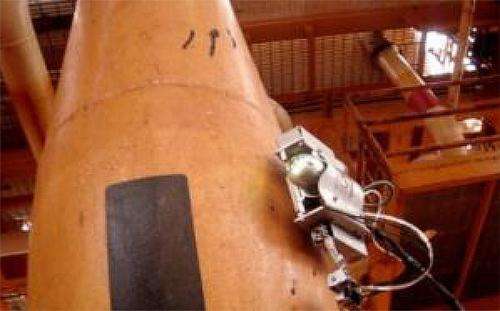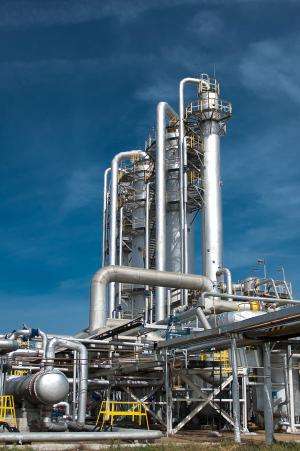Robot inspects pipes in petrochemical platforms

With the purpose of verifying onshore and offshore platforms such as Pemex's and detect cracks or corrosion, the Mexican Corporation of Material Research (COMIMSA) designed RoboPipe, a robot capable of inspecting the pipes in the chemical and petrochemical industry without risking personnel.
This technology simulates a remote control car with a camera and a measurement device installed; it climbs with the help of magnets and can overcome obstacles, like 90 degree elbows, while the floor personnel registers and monitors data.
Currently, the process pipes that are at a height of more than two meters in offshore or onshore platforms must be inspected by human staff that climbs through scaffolding.
RoboPipe performs corrosion measurements with ultrasound to locate and size the inner pipe damage. The prototype robot equipped with a camera and ultrasound system inspects pipes and visually verifies external corrosion.
Before using RoboPipe in offshore platforms, between four and six meters of pipe were inspected daily using scaffoldings. With the prototype designed by COMIMSA, between twelve and twenty meters of pipe can be inspected daily by control remote, according to tests conducted at Pemex facilities.
Jesús García Ortiz, from COMIMSA, explained that the camera RoboPipe carries, allows to work under humid conditions, has with good resolution, can record video and take photos; also, through ultrasonic technology it's possible to measure the thickness of the pipe.

He added that with RoboPipe's technology it's possible to reach inaccessible areas of offshore platforms, up to a height of eight meters, and measure pipes of a hundred millimeters of outer diameter.
"In COMIMSA we decided to design a very small robot so it could pass between two pipes, through a space of 88 millimeters; also, it had to have the grip to climb up a vertical pipe passing welded joints and not fall because of its own weight or the weight of the equipment it carries to transmit the signals", he said.
This project was designed in association with the Institute of Superior Studies of Monterrey (ITESM), Campus Saltillo, which was responsible of the electronic side of the scheme with staff specialized in mechatronics.
The robot first underwent tests at the laboratory; afterwards protocols were developed for tests at onshore and offshore facilities in the environment of chemical and petrochemical industry.
Jesús García Ortiz, said that a survey of the national market was made and RoboPipe can solve other inspection problems in ferromagnetic components inaccessible to human personnel such as buildings and bridges, storage tanks and pressure vessels, among others.
Currently, COMIMSA is improving the prototype and is developing two more robots, one for offshore platforms and one for onshore facilities.
Once both prototypes are validated, this product will be commercialized with licensing or sale options.
"At this moment we are working on bibliographical studies to develop a robot with a laser system that allows in depth measurement of superficial discontinuities on the outside of the pipes", García Ortiz said.
Provided by Investigacion y Desarrollo




















